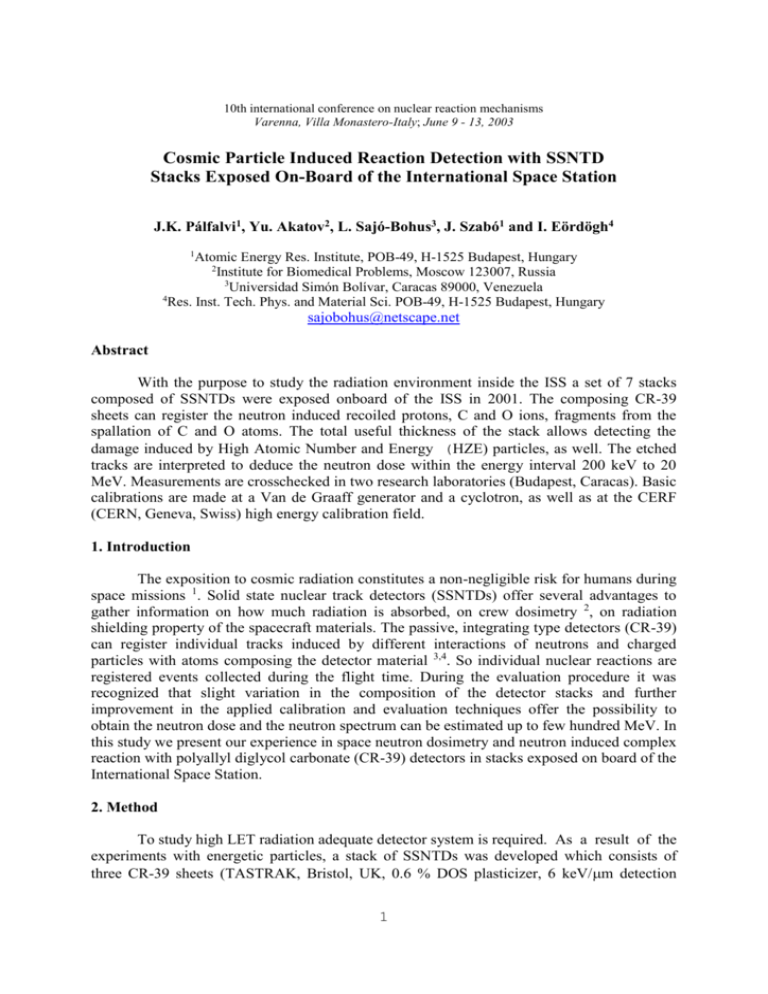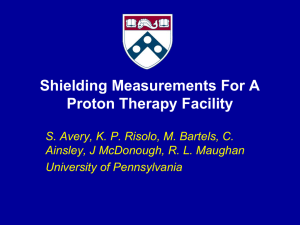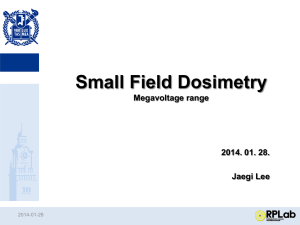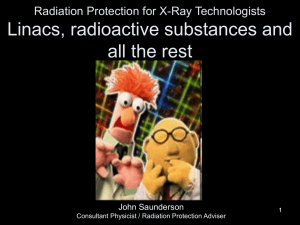HIGH ENERGY NEUTRON SPECTRUM AND DOSE
advertisement

10th international conference on nuclear reaction mechanisms Varenna, Villa Monastero-Italy; June 9 - 13, 2003 Cosmic Particle Induced Reaction Detection with SSNTD Stacks Exposed On-Board of the International Space Station J.K. Pálfalvi1, Yu. Akatov2, L. Sajó-Bohus3, J. Szabó1 and I. Eördögh4 1 Atomic Energy Res. Institute, POB-49, H-1525 Budapest, Hungary 2 Institute for Biomedical Problems, Moscow 123007, Russia 3 Universidad Simón Bolívar, Caracas 89000, Venezuela 4 Res. Inst. Tech. Phys. and Material Sci. POB-49, H-1525 Budapest, Hungary sajobohus@netscape.net Abstract With the purpose to study the radiation environment inside the ISS a set of 7 stacks composed of SSNTDs were exposed onboard of the ISS in 2001. The composing CR-39 sheets can register the neutron induced recoiled protons, C and O ions, fragments from the spallation of C and O atoms. The total useful thickness of the stack allows detecting the damage induced by High Atomic Number and Energy (HZE) particles, as well. The etched tracks are interpreted to deduce the neutron dose within the energy interval 200 keV to 20 MeV. Measurements are crosschecked in two research laboratories (Budapest, Caracas). Basic calibrations are made at a Van de Graaff generator and a cyclotron, as well as at the CERF (CERN, Geneva, Swiss) high energy calibration field. 1. Introduction The exposition to cosmic radiation constitutes a non-negligible risk for humans during space missions 1. Solid state nuclear track detectors (SSNTDs) offer several advantages to gather information on how much radiation is absorbed, on crew dosimetry 2, on radiation shielding property of the spacecraft materials. The passive, integrating type detectors (CR-39) can register individual tracks induced by different interactions of neutrons and charged particles with atoms composing the detector material 3,4. So individual nuclear reactions are registered events collected during the flight time. During the evaluation procedure it was recognized that slight variation in the composition of the detector stacks and further improvement in the applied calibration and evaluation techniques offer the possibility to obtain the neutron dose and the neutron spectrum can be estimated up to few hundred MeV. In this study we present our experience in space neutron dosimetry and neutron induced complex reaction with polyallyl diglycol carbonate (CR-39) detectors in stacks exposed on board of the International Space Station. 2. Method To study high LET radiation adequate detector system is required. As a result of the experiments with energetic particles, a stack of SSNTDs was developed which consists of three CR-39 sheets (TASTRAK, Bristol, UK, 0.6 % DOS plasticizer, 6 keV/m detection 1 threshold) of 1 mm thick having an area of 20 by 50 mm2. The 1st and 2nd sheets were separated by a thin, high purity Ti foil (50 m) of natural isotopic composition, the 2nd and 3rd sheets sandwiched a Lexan (General Electic, USA, foil of 350 m thick). The assembly is shown in Fig. 1. The stack was wrapped in a thin Al foil (30 m) and sealed hermetically in a polyethylene (PE) bag of 40 m thick (not shown). Fig. 1. Track detector assembly (stack) developed to determine the neutron dose on the ISS. The neutron detection between ~100 keV and 4 MeV incident energy is based on the neutron elastic scattering on Hydrogen atoms within the detector material (in all CR-39 sheets) and detecting protons generated in converter materials as the Lexan detector itself (CR-39 sheet No. 3). The role of the Ti foil is twofold: degrades the energy of the high energy recoiled protons (coming if coming at all from CR-39 sheet No. 2) to fall into the detectable energy range (as above) and it works as a threshold detector utilizing the Ti(n,p)Sc reaction. The effective threshold is at ~2 MeV, extending the detectable neutron energy range up to ~20 MeV. The role of the Lexan detector is to register cosmic ray particles (Z>2). Seven identical stacks were manufactured and delivered to the ISS. Another 8 stacks, 6 different configurations, were exposed at the CERF high energy calibration field (Geneva, Swiss) between 4 and 8 Oct. 2001, for calibration purposes. Etching conditions for latent track enlargements were: 6N NaOH, 70 oC, etching time 2-12 h (in steps). Etched tracks were analysed using the VIRGINIA digital image analyzer system installed at Budapest and Caracas. The neutron detection response of each surface was studied by the MCNP-4B, SRIM2000, PROTON2002 (locally developed, not published) and VIFAN2002 codes. The low energy proton response was tested by exposing the detectors to monoenergetic protons produced by a Van de Graaff generator. 2 Individual tracks were classified depending on their geometrical shape and track parameters. Statistical analysis resulted in the dose estimation. 3. Results 3.1 Neutron induced proton-tracks The number of circular tracks was counted on each detector sheet and the track densities obtained were compared. The dose values were deduced from each possible comparison to the calibration detectors and averaged for a given detector location. Since the CERF calibration spectra are somewhat different from the spectra at different positions inside the ISS, the overall uncertainty of the averaged dose rate has been estimated to be below 30%. In Table 1 the neutron ambient dose equivalent rates are given for neutron energy between 200 keV and 20 MeV for different locations on the spacecraft. The dose in this range can be 60 % of the total neutron dose. H* rate Sv/d #1, A11 #2, A12 panel panel 443 240 52 39 Table 1 Location in the ISS #3, A13 #4, A14 #5, A15 #6, A16 panel panel panel panel 110 457 318 110 47 54 73 68 #7, A16 panel 110 orthogonal 63 Average 56.6 21% The dose results shown in Table 1 can be, up to a given extent, compared to the results presented in other papers as shown in Table 2. Table 2 Location, author, Date, Reference ISS, Russian segment ‘Zvezda’, Palfalvi, 2003, this paper ISS, American Segment, E. Benton, 2002 5 STS-108, O’Sullivan, 2002 6 STS-108, Bartlett, 2002 7 STS-105, Bartlett, 2002 7 STS-91, Tawara, 2002 8 STS-91, Doke, 2002 9 STS-84, Tawara, 2002 8 STS-84, Doke, 2002 9 STS-84, Luszik-Bhadra, 1999 10 STS-79, Doke, 2002 9 MIR, Doke, 2002 9 MIR, Spurny, 2002 11 MIR, Luszik-Bhadra, 1999 10 # Averaged, see Table 1. * Either H*(10) or not defined ** Different locations 3 Dose equivalent rate * Sv/d 94 # 173 190 130 120 171 183 141 341 109, 125 ** 333 200 85, 118 ** 66, 78, 235 ** 3.2 Complex reaction analysis Fast neutrons may induce complex reactions in the detector. Among the possible multiparticle break up reactions we consider the 12C(n,n’3α). The procedure for measuring the three alpha events includes the assumption that the produced latent track is related to the etched track geometrical parameters. From these the correlation to the energy and direction of the three alpha particles can be obtained. In general terms it is usually accepted in the literature to assume that during the etching the ratio track velocity/bulk velocity is constant and the track evolution doesn’t suffer from measure distortion. In figure 2 we present an etched track as observed under a transmission microscope and the possible geometrical interpretation of the above mentioned reaction. Fig.2. Geometrical scheme for complex reaction analysis In the Fig. 2 we represented the estimated tracks induced by the alpha particles α1, α2 and α3 with inclination angle θ and declination angle φ in the reference frame XYZ. The coordinate system for triple alpha track analisys has its origin where the reaction takes place. We consider only those reaction products that emerge on a given plane indetifyed by α3 // XY. In this plane we estimate the position of the latent track and from the digitalized image we deduce the geometry of the track mouth. The shape usually is the superposition of three ellipses having different eccentricity. The parameters allow us to determine in principle the direction and the energy. Taking into account the Bragg curve, the energy of the alpha particle could be estimated. The process required to deduce the individual track parameter from the digitalized image is similar to the unfolding technique. This includes first the selection of the largest section that we assume to be the track etched for the longest time: in this case the central track. The diameter allow to determine the energy (E2); the eccentricity will give us 4 the inclination (2) and the projection on XY is the declination (2). Similar procedures define E1, E3 with the respective angles. 4. Conclusions Neutrons have been studied utilizing elastic scattering on Hydrogen atoms and the (n,p) reaction of Titanium. The SSNTD method allowed to determine neutron ambient dose equivalent (H*) in the energy range between 200 keV and 20 MeV, based on calibration made at the CERF facility (CERN). The uncertainty of the averaged dose is around 30% and the contribution to the total neutron ambient dose equivalent is around 60%. In the literature it is reported that the average dose equivalent estimated for neutrons is between 68 mSv/d (mission MIR92) and 228 mSv/d (mission STS84). Our results are not outstanding. It has been reported that the neutron dose contribution, under the conditions given here, to the total dose is less than or around 20%. Tracks related to the spallation effect of Carbon and Oxygen atoms induced by high-energy neutrons and protons as well as cosmic ray tracks have been recorded and their interpretation is still in progress. 5. Mission Information Stacks launched on 26-02-2001 by Progress 244. Returned to Earth on 31-10-2001 by Soyuz TM-32. Received at the Lab on 28-03 2002. Evaluation started 02 -04 2002 and is in progress. References 1. Reitz G., 2001, EUROPEAN Dosimetry Activities for the ISS, Physica Medica V. XVII, suppl.1, pp. 283-286. 2. Benton E.R., Benton E.V., Frank A.L., 2002, Passive dosimetry aboard the MIR ORBITAL STATION: external measurements, Radiat. Meas. V. 35, 457-471. 3. Pálfalvi J.K., Sajó-Bohus L., Balaskó M. and Balásházy I., 2001, Neutron field mapping and dosimetry by CR-39 for radiography and other applications, Radiat. Meas. V. 34 (16), pp. 471-475. 4. Pálfalvi J.K., Sajó-Bohus L. and Blaskó M., 2002, Realistic neutron spectra for radiation protection and other applications at AERI, Budapest, Nucl. Instr. Meth. Phys. Res. A 476, pp. 452-456. 5. Benton, E. R., 2002, Progress in Analyzing Results from the ISS Passive Dosimetry System during the DOSMAP Experiment, presented on the 2nd DOSMAP Results Workshop, Krakow, Poland, July, 2002. 6. O’Sullivan, D., Zhou D., Semones E., Heinrich W., Flood E., 2002, Charge Spectrum, Dose Equivalent and Absorbed Dose Investigation on STS-108, presented on the 2nd DOSMAP Results Workshop, Krakow, Poland, July, 2002. 7. Bartlett, D. T., Hager L.G., Tanner R.J., 2003, The Determination of the Neutron Component of Cosmic Radiation Fields in Spacecraft, Presented on 21st Int. Conf. on SSNTDs, New-Delhi, October, 2002. 8. Tawara, H., Doke T., Hayashi T., Kikuchi J., Kyan A., Nagaoka S., Nakano T., Takahashi S., Terasawa K., Yoshihira E., 2002, LET Distributions from CR-39 Plates on Space Shuttle Missions STS-84 and STS-91 and a Comparison of the Results of the CR-39 Plates with those of RRMD-II and RRMD-III Telescopes, Radiat. Meas. V. 35, pp. 119126. 5 9. Doke, T., Hayashi T., Kikuchi J., Nagaoka S., Nakano T., Takahashi S., Tawara H., Terasawa K., 2002, Dose Equivalents inside the MIR Pace Statio Measured by the Combination of CR-39 Plates and TLDs and their Comparison with those on Space Shuttle STS-79, -84 and 91 Missions, Radiat. Meas. V. 35, pp. 505-510. 10. Luszik-Bhadra, M., Matzke M., Otto T., Reitz G., Schuhmacher H., 1999, Personal Neutron Dosimetry in the Space Station MIR and the Space Shuttle, Radiat. Meas. V. 31, pp. 425-430. 11. Spurny, F. and Dudkin, V. E., 2002, Dosimetry and Microdosimetry Characteristics Measured onboard the MIR Station during the 28th Basic Expedition, Radiat. Meas. V. 35, pp. 539-543. 6







